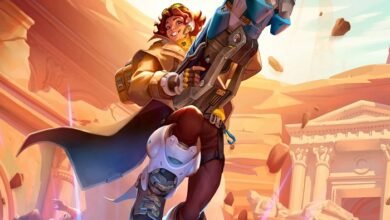Overwatch Rank Distribution: A Comprehensive Analysis

Introduction
Overwatch rank distribution is a topic of perennial fascination among players, enthusiasts, and analysts alike. Understanding the distribution of ranks across the player base sheds light on the competitive landscape of Blizzard Entertainment’s popular team-based shooter. From the lowest tiers of Bronze to the pinnacle of Grandmaster, the journey through Overwatch’s ranks is as diverse as the heroes themselves.
Exploring the Overwatch Ecosystem
In the vast ecosystem of Overwatch, rank distribution serves as a barometer of skill and progression. The distribution curve provides a snapshot of the player base, showcasing the proportion of players at each tier. Whether you’re a casual player or a seasoned competitor, navigating through the ranks is a rite of passage in the Overwatch universe.
The Pyramid of Skill: Understanding Rank Tiers
At the foundation of Overwatch’s rank distribution lies the Bronze tier, where players embark on their competitive journey. As players hone their skills and strategize their way through Silver and Gold, they ascend the pyramid of skill towards Platinum and Diamond. The elite ranks of Master and Grandmaster represent the pinnacle of competitive achievement, reserved for the most skilled players in the Overwatch community.
Factors Influencing Rank Distribution
Several factors influence Overwatch rank distribution, shaping the landscape of competitive play. Player skill, teamwork, communication, and game sense all play pivotal roles in determining one’s rank. Additionally, external variables such as meta shifts, balance updates, and seasonal events can impact the distribution curve, leading to fluctuations in player ranks over time.
Challenges and Opportunities at Each Tier
Each tier in Overwatch presents its own set of challenges and opportunities for players. From overcoming mechanical hurdles in Bronze to mastering advanced strategies in Grandmaster, the journey through the ranks is a testament to perseverance and adaptability. Embracing the learning curve at each tier is essential for growth and improvement as a player.
Matchmaking Dynamics: Balancing Skill and Fairness
Matchmaking lies at the heart of Overwatch’s competitive experience, striving to create balanced and fair matches for players of all skill levels. By analyzing rank distribution data, developers can fine-tune matchmaking algorithms to ensure optimal player experiences. Balancing skill disparities and queue times remains a continuous challenge in the quest for a seamless matchmaking system.
Community Insights and Perspectives
The Overwatch community offers a wealth of insights and perspectives on rank distribution, enriching the discourse surrounding competitive play. From forum discussions to content creators’ analyses, players share their experiences, strategies, and frustrations across various platforms. Engaging with the community fosters camaraderie and mutual learning, enhancing the overall Overwatch experience.
Strategies for Climbing the Ranks
Climbing the ranks in Overwatch requires dedication, strategy, and a growth mindset. Whether you’re solo queuing or forming a team, adopting effective communication and teamwork can significantly impact your climb. Studying hero mechanics, map strategies, and game sense empowers players to make informed decisions and outplay their opponents at every tier.
The Role of Esports in Shaping Rank Distribution
Overwatch esports serves as a catalyst for innovation and excellence within the competitive scene, influencing rank distribution trends and player aspirations. Aspiring professionals look to top-tier players for inspiration and guidance, striving to emulate their strategies and playstyles. Esports tournaments and leagues showcase the highest levels of skill, setting benchmarks for players across all ranks to aspire to.
Addressing Common Misconceptions
Misconceptions abound when it comes to Overwatch rank distribution, ranging from the perceived difficulty of climbing ranks to the prevalence of smurfing and boosting. Dispelling these myths requires a nuanced understanding of the factors at play, including player behavior, matchmaking dynamics, and statistical anomalies within the distribution curve.
The Future of Overwatch Rank Distribution
As Overwatch continues to evolve and adapt, the future of rank distribution holds promise for innovation and refinement. With ongoing updates, balance changes, and community feedback, Blizzard Entertainment remains committed to fostering a competitive ecosystem that is inclusive and rewarding for players of all skill levels. The journey through Overwatch’s ranks is a dynamic and ever-changing adventure, inviting players to embark on new challenges and experiences.
Conclusion
Overwatch rank distribution is a multifaceted phenomenon that reflects the diversity and dynamism of the game’s competitive landscape. By delving into the intricacies of rank tiers, matchmaking dynamics, and community insights, players can gain a deeper appreciation for the journey from Bronze to Grandmaster. As Overwatch continues to captivate players worldwide, rank distribution serves as a testament to the game’s enduring legacy and the passion of its community.
FAQs:
1.Q: Is it harder to climb ranks in Overwatch compared to other competitive games?
A: Climbing ranks in Overwatch can be challenging due to the game’s emphasis on teamwork and coordination, but with dedication and strategy, players can steadily progress through the tiers.
2.Q: How often does Blizzard adjust the matchmaking algorithms in Overwatch?
A: Blizzard regularly updates matchmaking algorithms based on player feedback and data analysis to improve the overall competitive experience.
3.Q: What impact do balance updates and meta shifts have on rank distribution?
A: Balance updates and meta shifts can influence rank distribution by affecting hero viability and player strategies, leading to fluctuations in the distribution curve over time.
4.Q: What measures does Blizzard take to address smurfing and boosting in Overwatch?
A: Blizzard employs various measures, including detection algorithms and enforcement actions, to combat smurfing and boosting and maintain the integrity of competitive play.
5.Q: How can players contribute to shaping the future of Overwatch rank distribution?
A: Players can contribute to shaping the future of Overwatch rank distribution by providing feedback, participating in community discussions, and striving for fair and respectful gameplay.





